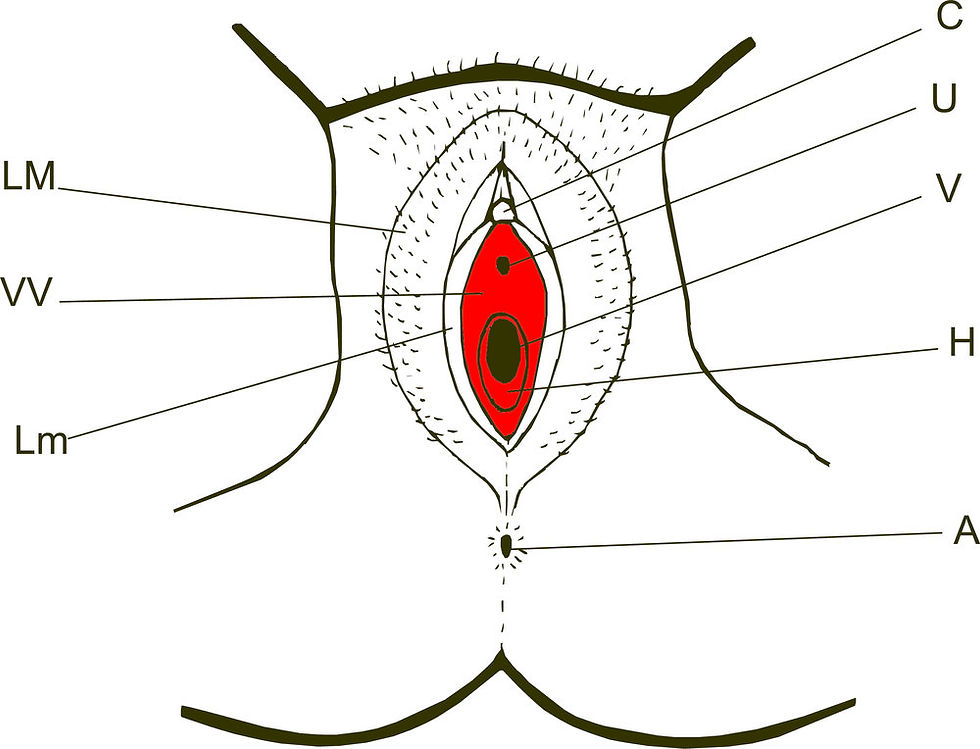The Very Vexing Vulvodynia
- Goneuptothesky

- Nov 2, 2020
- 3 min read
Updated: Nov 27, 2020

What is Vulvodynia? It literally translates to pain in the vulva (the outer skin before the vagina). This pain may feel like burning, rawness, aching, stinging, or itching that lasts for more than 3 months, and therefore is chronic, and isn't related to an infection or skin condition. The area highlighted in red below represents the Vestibular Vulva, so you can see how it rests between the vagina and the labia minora.

What types are there? First, there is localized (specific to a certain area) which is often around the vestibule (entrance to the vagina, shown below in the left pic) and called Vestibulodynia, but can also be pain in the clitoris and called Clitodynia. This type is considered provoked if it is only brought on by touch, such as wearing tight clothing, having sex, inserting a tampon, getting a pelvic exam, or sitting for long periods of time. Generalized occurs spontaneously and pretty constantly without much relief, known as unprovoked, and shown below in the right pic. The same activities can exacerbate these symptoms as well. Just like with Vaginismus, Vulvodynia is further classified as primary (never had penetrative sex without pain) or secondary (pain occurred one day after previously pain free intercourse).

What causes Vulvodynia? The causes vary from person to person, which is what makes getting a diagnosis so difficult in the first place. For some women it comes from eating an inflammatory diet, others from wearing non-cotton undies, others have a nerve issue, such as Pudendal Neuralgia, and others still have no idea. The most frustrating part, at least to me, is that this pain you experience in the vulva can either lead to Vaginismus, as your body clenches in response to the physical pain you are feeling, OR Vaginismus can cause Vulvodynia, as the constant clenching of your PC muscle leads to a weak pelvic floor and thus can create nerve pain in your vulva.
How do I treat it? As you read in the previous paragraph, the root of your Vulvodynia can be hard to pinpoint, but finding it is the best way to approach beating it. Although it is considered a chronic condition, please know that many women are able to find ways around that, whether they cure it completely or find a special way to manage it. It's important to get a diagnosis from a gynecologist so he or she can help you come up with a plan. To test for Vulvodynia the doctor will take a Q-tip and lightly press into different parts of the vulva to see where you feel pain. This will help determine which type you have and where your trouble spots are. A gyno can also give you a referral for pelvic floor physical therapy, which has helped many women on their pain recovery journey. For more details on how they help, you can read my blog from last month about what these physical therapists do here. Other treatments include a low-oxalate diet (anti-inflammatory), wearing 100% cotton underwear, wearing loose clothing, stretching the pelvic area, applying an ice pack or natural cream designed to alleviate irritation in the area, and last but not least, having a partial Vestibulectomy or a full Vulvectomy (surgical removal of the vestibule where the skin from inside of the vagina is pulled forward to form a new vulva). I had the latter 3 years ago and will feature a post describing the experience at a later date, for anyone who is considering it themselves.

Here is a list of brands that carry products I personally recommend. Intimate Rose has a cream balm that can be very soothing when you apply it to an irritated vulva, along with other lubricants and products designed for women who experience painful sex. Desert Harvest has aloe vera based products made for women with Interstitial Cystitis, but they also work great for Vulvodynia, since anyone with pain in the vulva for whatever reason can benefit from some relief. I recommend the Aloe Glide lubricant made thick for women with irritation, or even the Releveum Skin Repair Cream, which has 4% Lidocaine in it for some extra pain relief. For more information on this condition, the Vulvodynia Association is a great place to start. They are full of resources for every stage of your vulva exploration journey and offer a plethora of information to guide you to a pain free future!




Comments